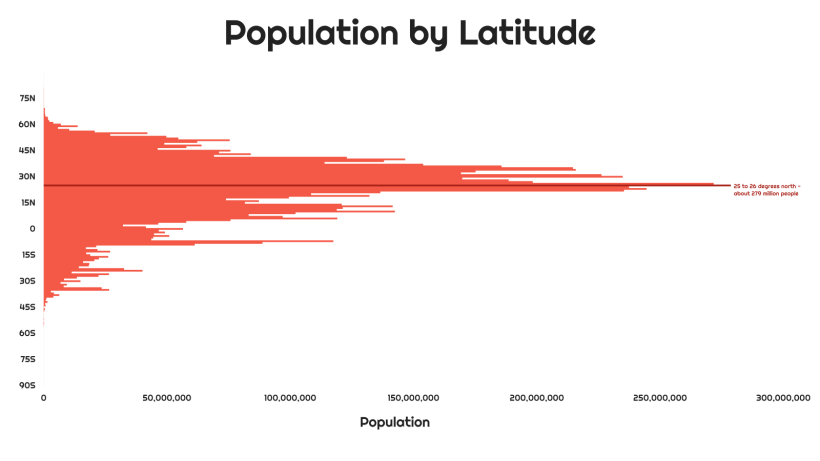Mapped: The world’s population density by latitude

A map of the world showing population density by latitude
Image: Visual Capitalist/WORLDPOP.ORG, 2020
Stay up to date:
Future of Work
- Numerous factors influence an area’s population density, from physical terrain to climate.
- This world map shows that population becomes more concentrated near the equator, with the 25th and 26th parallel north the most densely populated latitude circles.
- Around 279 million people live in these latitude lines, which run through large countries like India, Pakistan, Bangladesh, China, the United States and Mexico.
- This biggest rise in population this century is expected to be in Africa, meaning there could be even higher densities at latitudes near the equator.
When you think about areas with high population densities, certain regions spring to mind. This could be a populous part of Asia or a cluster of cities in North America or Europe.
Usually density comparisons are made using cities or countries, but this map from Alasdair Rae provides another perspective. This world map depicts population density by latitude, going from the densest populated coordinates in deep red to the sparsest in light blue.
What’s the World Economic Forum doing about climate change?
Why certain latitudes (and regions) are more densely populated
Numerous factors affect an area’s population density. These can range from topography, or the physical terrain characteristics of the place, to more direct factors like an area’s climate, which can impact both the survivability and agricultural potential.
Political, economic, and social factors are also at play—for example, there is a natural lack of livelihood opportunities in sparse areas such as the Amazon rainforest or the Himalayas.
Breaking down the population by latitude, we see the population becomes more concentrated near the equator. In particular, the 25th and 26th parallel north are the most densely populated latitude circles. Around 279 million people reside in these latitude lines, which run through large countries like India, Pakistan, Bangladesh, China, the United States, Mexico, and others.
Despite their large landmasses, many of these countries do not themselves have very high population densities. Since density measures the ratio of people to physical space, countries with vast but sparse regions like China and India are less dense than imagined.
Out of the top 10 most densely populated countries in the world, only a couple can be found on the 25th and 26th parallel north—Bangladesh and Bahrain. For a size comparison, Bangladesh is 1.55% the size of China, and Bahrain is only 0.01%.
The future of population density near the equator
Looking ahead to 2100, the UN projects that the global population will rise to almost 11 billion. This would increase global population density from 59.11 people per square kilometer in 2022 to 80.82 per square kilometer in 2100.
However, the projections show that Asia will not be the biggest contributor to this growth. Instead, the most considerable jump in population is predicted for Africa, set to grow by almost 200% from almost 1.5 billion people today to 4.3 billion in 2100.
The equator runs right through the middle of Africa and crisscrosses countries like the Congo (both the Republic and DRC), Kenya, Gabon, Uganda, and Somalia.
As Africa’s population expands, this means that at latitudes near the equator, there could be even higher population densities coming. Or course, this largely depends on how the world’s fastest growing cities—most of which are in Africa—shape up over the coming decades.
Accept our marketing cookies to access this content.
These cookies are currently disabled in your browser.
Don't miss any update on this topic
Create a free account and access your personalized content collection with our latest publications and analyses.
License and Republishing
World Economic Forum articles may be republished in accordance with the Creative Commons Attribution-NonCommercial-NoDerivatives 4.0 International Public License, and in accordance with our Terms of Use.
The views expressed in this article are those of the author alone and not the World Economic Forum.
Forum Stories newsletter
Bringing you weekly curated insights and analysis on the global issues that matter.
More on Jobs and the Future of WorkSee all
Jovan Jovanovic and Dino Osmanagić
May 16, 2025
Silja Baller
May 15, 2025
Rya G. Kuewor
May 13, 2025





